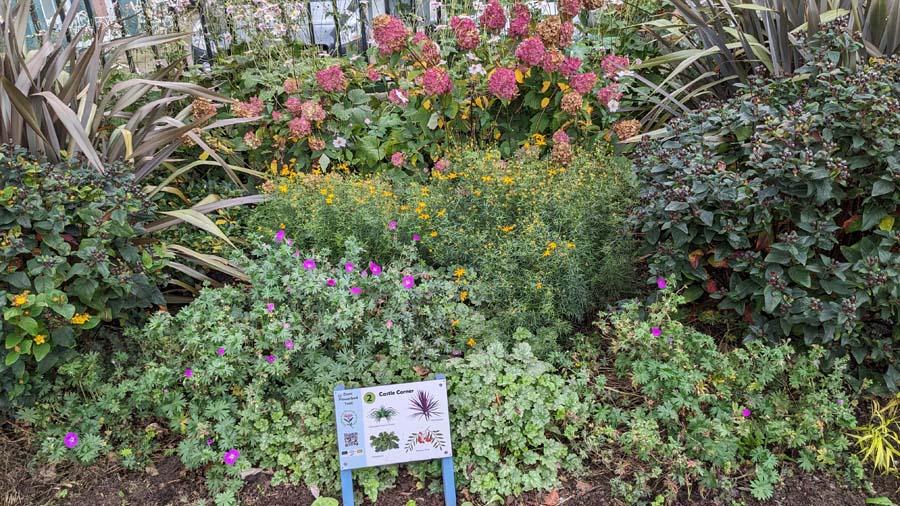
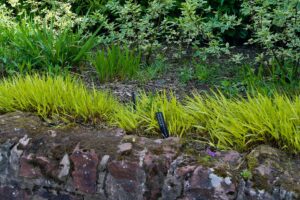 |
Tempting Texture --- Hakonechloa Grasses also known as Japanese forest grass | Hakonechloa. These beautiful feathery grasses thrive in wet and rocky places. They spread slowly. Look for soft arching tufts of slim green leaves that sway gently in the breeze. --- Did you know? The leaves of this bright green plant develop red and brown tints in Autumn. |
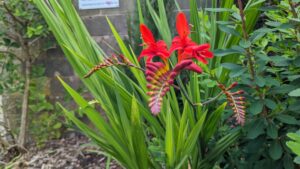 |
Robust and Reliable --- Crocosmia also known as Monbretia | Crocosmia. These easy to grow plants come in a range of hot fiery orange, red and yellows. In mid to late Summer look out for their lovely thin sword like leaves and slender arching stems of little funnel shaped flowers. The flowers of Crocosmia are usually orange, red or yellow. --- Did you know? It is illegal to plant or allow common Crocosmia to grow in the wild as it is invasive. It can escape from gardens into the wild and crowd out native plants. |
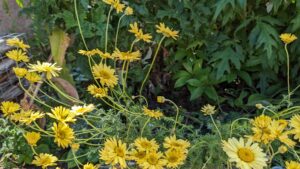 |
Wildlife Welcomer --- Coreopsis also known as Tickseed | Coreopsis is an excellent plant for attracting wildlife. Butterflies and bees love them and birds will eat the seeds. The daisy-like flowers grow in bright warm tones of lemon, orange, apricot and red. In Castle Corner look for yellowy orange dainty ‘dancing’ flowers from early to late summer. --- Did you know? The Victorians associated Coreopsis with love at first sight and cheerfulness. |
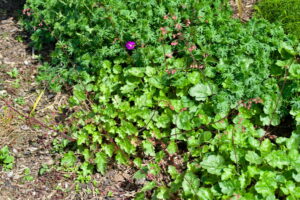 |
Fantastic Foliage --- Heuchera also known as Coral Bells | Heuchera. The leaves are the beauties on these almost evergreen plants. Look for their attractive scalloped lobed leaves in vibrant shades of purple and red. Heuchera also grow in stunning lime green, apricot, pink and bronze leaf colours. In Spring they send out tall thin stems with clusters of little creamy white, pink or red flowers. Heucheras are almost evergreen as long as they don’t get too wet or too hot. --- Did you know? The common name is ‘Coral Bells’ because of the little bell-like flowers it produces. |
 |
Fantastic Foliage --- Variegated Cornus also known as Dogwood | Cornus shrubs provide interest all year round. The dense green and cream leaves on this Cornus turn a beautiful red in the Autumn and produce small clusters of creamy flowers and berries. In Winter when the leaves fall off and the stems are exposed they are a brilliant crimson red. --- Did you know? The smooth straight twigs were used to make butchers’ skewers. ‘Dag’ used to be another name for skewers so the name means skewer wood. |
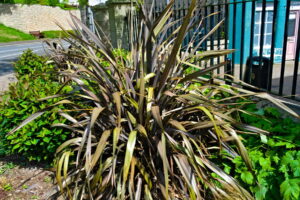 |
Fantastic Foliage --- Phormium also known as New Zealand Flax | Phormiums. These stunning tall clump forming plants have long upright sword like or slightly arching leaves. Phormiums are evergreens. They come in many shades of yellow, greens, reds and purple. They are often stripy and variegated. In the summer you may spot tall leafless stems bearing tubular flowers. Be careful they can be sharp and spikey. --- Did you know? Phormiums originate in New Zealand. They have traditionally been used for rope making and weaving . They don’t always like the frost so may need protecting in harsh weather. |
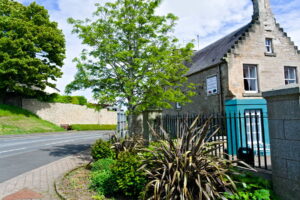 |
Seasonal Showstopper --- Rowan tree also known as Sorbus or Mountain Ash | Rowan Tree. These beautiful small trees provide lots of seasonal interest. In Spring look for flat clusters of creamy white flowers. In Autumn look for bright orange red berries. Rowan Trees can also have yellow, red or pinky white berries. --- Did you know? Rowan trees can live for up to 200 years. Birds love to eat the berries and thrushes will even guard a tree to keep the berries all to themselves. Humans should not eat the raw berries |
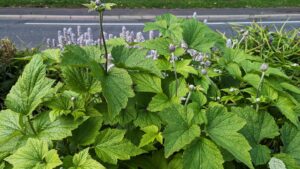 |
Seasonal Showstopper --- Japanese anemone | Japanese anemones Look out for these tall graceful flowers in the Autumn. They will be lighting up a semi shade moist corner at the back. They have tall upright stems with little saucer shaped flowers. Our flowers are tall and pink but anemones also grow in soft creamy white shades and shorter varieties too. --- Did you know? Anemones spread rapidly so they do need to be kept under control. They really don’t like being moved but they will grow easily from tiny pieces of root cutting. |
Cross the main road behind you. With The Horn pub on your left walk up the slight hill to reach Clouds bed.
Disclaimer
Our plants are grown for ornamental purposes only. We do not advise touching or ingesting any parts of the plants on the Duns Flowerbed Trail. Many plants can be an irritant or toxic when smelt, ingested or touched. All the ‘Did you know?’ information about alternative plant use is provided for educational interest only.
